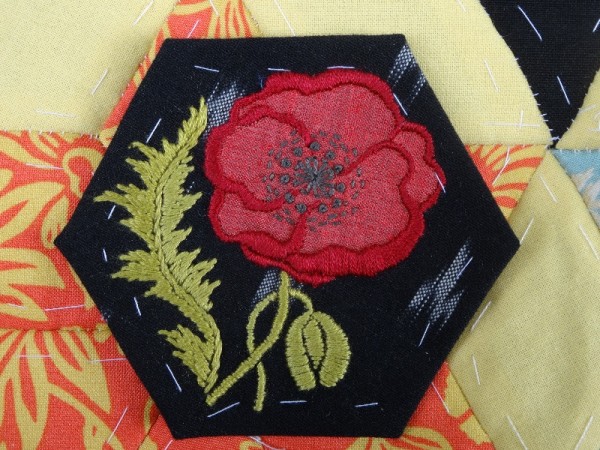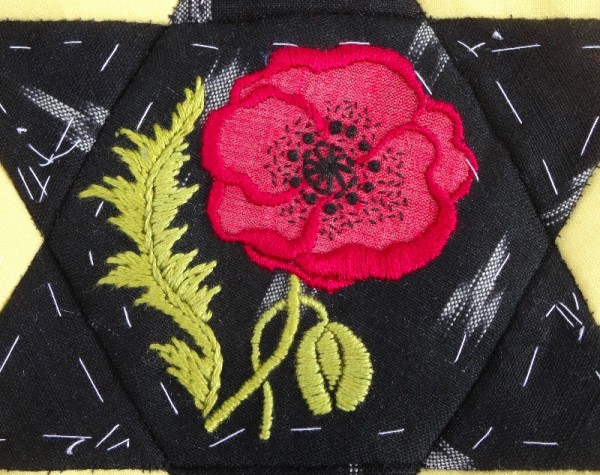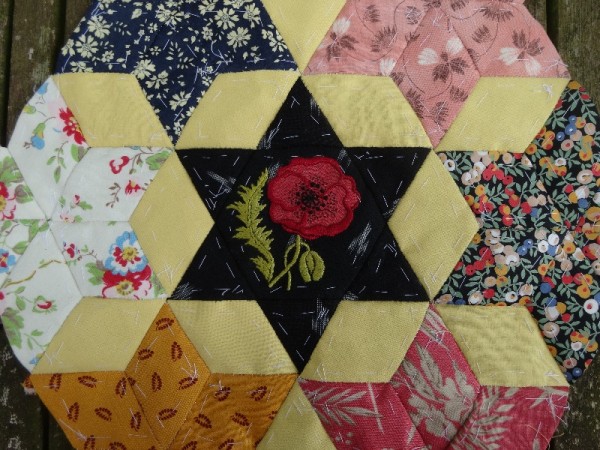Comparing the two poppies, it becomes quite clear that the revised one is so much better than the original which is a bit weak and tentative. This is a fact of creative life, I think and shows how sometimes things sort themselves out when you put them to one side and come back to them later. I remember having particular trouble with the leaf which I became more incapable of getting to look right the more I scoured the internet and books for ones to be inspired by. The flower is also more pleasing in shape.
I have been reading more of Molly Peacock’s The Paper Garden about Mrs Delany and I can see why the woman who sold it me in the Oxfam shop (who I suspect had actually donated it) might have found herself raising her eyebrows as she read it. Ms Peacock seems to me to go a bit overboard on the sexual imagery. Early on in the book, she makes an appointment in the Prints and Drawings Study Room of the British Museum to see some of the 850 of Mrs Delany’s works and comments as follows:
“The flowers are portraits of the possibilities of age. They are aged. They can be portraits of sexual intensity – but softened. Softer and drier, as our sexuality becomes. Yet they can also be simple botany, nearly accurate representations of specimens. They all come out of darkness, intense and vaginal, bright on their black backgrounds as if, had she possessed one, she had shined a flashlight on nine hundred and eighty-five flowers’ c….”
I’m sorry, I’m not of a generation that is at ease writing the required final word, even if it is there in the book in black and white. And I do think the author has stretched her over imaginative sexual parallels further than there’s any indiction that they might in reality have cause to go. Hmm more informative about Molly Peacock than Mrs Delany, I think.
I shall, nevertheless, continue with the book as I know Molly Peacock manages to curb her colourful imagination and get on with telling a good story. I particularly enjoy her recounting how in 1955 an earlier biographer Ruth Hayden (a gt-gt-gt-gt-gt-gt niece of Mrs Delany), having been taken to see the paper cuts as a child, is feeding alphabet soup to her children one lunch time and an image of the glorious flowers comes into her head. Suddenly Ruth is gripped by the desire to see them once more and to give her two small children the experience she had had – but it couldn’t wait, she had to take them then, that day, straightaway. In a great whirl she dresses them, rushes to the train, all legs pumping like billyo, bustles them all on the underground from Waterloo to Russell Square, careers across the front courtyard of the British Museum, pushes the children upstairs and no doubt out of breath presses the little buzzer for access to the Prints and Drawings Study Room. It was 4.01 pm. The Study Room closed at 4.00 pm.
Happily the door was opened by a true gentleman of a curator and Ruth and her children were able to spend an hour looking through the first volume of their ancestor’s work.
Earlier this year my husband, art historian and parish priest, also had cause to visit the The Prints and Drawings Room in the British Museum to tell them of an error he had found in their catalogue (yes, he’s a finger nail monitor too). We were amused that the email directed him to
” ring the doorbell behind the Michelangelo cartoon, someone will let you in”.





4 Comments
Oh what a wonderful direction! ‘First left past the Louvre’ was my best one, when being directed to a friend’s apartment many years ago, but I may have been pipped there by Michelangelo! And ‘cartoon’ is just so perfect! Sounds like the book is quite a wince-making read, I could no more write than say or think the word, and would feel a uncomfortable reading it too. Good for you persevering with it. Perhaps that was the mute message being relayed by the lady in Oxfam?? X
Directions to anywhere around the Louvre would be very acceptable!
As to the book, I think I’ll just censor it as I read as the Mrs D.bits are fascinating. Now I want to read Ruth Hayden’s book as well.
With you on this one Mary…. however, perhaps the book progresses? Love the updated poppy – it seems to have more of an elegant flow to it. Now, poppies always remind me of Edgar Allan Poe as they are all over the embossed leather cover of an ancient copy I have somewhere on my bookshelf – and at the moment I also feel very sleepy – Papaver somniferum.
Glad you can see how my poppy drawing has improved, but it is supposed to be the common field poppy (Papaver rhoeas). I hope to do the Opium Poppy (Papaver somniferum) that you mention sometime soon. This year we had them growing commercially in the field behind us and for a couple of weeks they are amazing – white with a mauve blush, wierdly looking like a field of snow in late June!
One Trackback
[…] embroider this time is one taken from the book I’ve been reading on Mary Delany (mentioned here). I will add a photograph of the lily plate from the book tomorrow when I return to London for […]